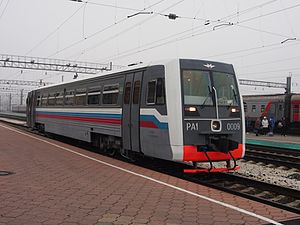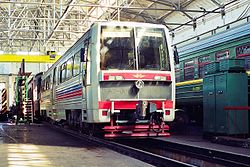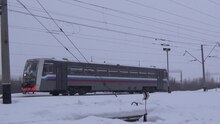RŽD series Pa1
| RŽD series PА1 (RA1) metro wagon machine type 730,730.15,731,731.15 |
|
|---|---|
|
RA1-0009
|
|
| Numbering: | for RŽD : RA1.0001-0088, RA1.0090, RA1.0092, RA1.0094 |
| Number: | for RŽD: 91 |
| Manufacturer: | Mytishchi wagon factory |
| Year of construction (s): | 1997-2006 |
| Axis formula : | B'2 ' |
| Gauge : | 1,520 mm |
| Empty mass: | Model 730: 32t Model 731: 37t |
| Service mass: | Model 730: 43t Model 731: 48t |
| Top speed: | 100 km / h |
| Installed capacity: | for MTU diesel engine: 315 kW |
| Motor type: | Model 730: Cummins from Model 731: MTU 6R183 TD13H |
| Motor type: | Diesel engine from different manufacturers |
| Power transmission: | hydrodynamic |
| Brake: |
pneumatic brake retarder |
| Seats: | Model 730: 62 Model 731: 78 |
| Standing room: | Model 730: 78 Model 731: 82 |
| Classes : | 2. |
The diesel railcar РА1 ( RA1 ) was built at the Mytishchi wagon factory in Mytishchi for the RŽD railways for fast suburban traffic on broad-gauge lines.
The railcars also have the factory designations model 730 , model 730.15 , model 731 and model 731.15 . The vehicles are used on the railways in Russia , there are also modified models for subways and as the MÁV series 6341 for the Magyar Államvasutak . The railcar has a driver's cab at both ends of the car body . With multiple controls , two to three vehicles can be operated. The РА1 family exists in six models; four for use in Russia and two for export. The car body as well as the drive and chassis technology have been developed on the basis of the Яуза ( Jausa ) subway car .
history
The first vehicle was delivered in 2000 and put into service in the Otroschka depot of the Yugo-Vostochnaja zhelesnaja doroga . The second vehicle, after being checked on the track ring of the All-Russian Research Institute for Rail Transport in Shcherbinka, reached the Kaliningrad Railway Company in 2002 . The third copy was designed for production with domestic components. This production dragged on for a long time.
In the first two vehicles, the diesel engine and transmission were designed with an import variant. All three differed in construction details. The first model was equipped with Scharfenberg couplers, they had doors for high platforms . Later the couplings were exchanged for those of the SA-3 type . They were sent to Dubna .
In 2004 the series went into series production. Their area of application spread to many railway lines in Russia. In 2005, 38 rail buses were manufactured. At the end of 2006 the number of vehicles built for the RŽD totaled 91. There were also versions for export (41 vehicles) and for use in underground trains.
Models for the market in Russia
PA1 model 730
This model has an entry in the middle of the car body. The doors are designed for high platforms. This model has pull-out sliding steps for low platforms. The doors are double sliding doors of the swivel-sliding door design, which are remote-controlled from the driver's cab. This model has 62 seats, the total passenger capacity is 140 people. The empty weight is 32 t, the service weight 43 t. The vehicle is equipped with the hydrodynamic brake and the pneumatic brake . The car body is supported on the two bogies primarily via coil springs and hydraulic dampers, and secondarily via pneumatic suspension with hydraulic dampers.
The box is an all-metal construction and is made of stainless steel . Beads have been added to increase strength. The power unit consists of the Cummins diesel engine , which complies with the Euro2 standard. The fluid transmission was manufactured by Voith .
The maximum speed of the vehicle is 100 km / h. A copy with the designation PA1.0001 was built . Originally the vehicle was used in Dubna on the Dubna - Bolshaya Volga section .
PA1 model 730.15
This is a variant of the model 730 , which is intended for subways. Outwardly, it does not differ from the 730 variant . Compared to those of the RŽD, the vehicles have two-part serial numbers, starting with PA1.01 . Seven vehicles were produced. They have the nickname Рауза ( Rausa ) among railway enthusiasts , this is derived from the Ra rail bus and Яуза ( Jausa ) metro car.
PA1 model 731
In contrast to the 730 model, the 731 model has two doors at the ends of the cart. The doors are double sliding doors in a lean-to-slide design that are designed for use on high platforms. Extendable sliding steps are available for use on low platforms. In contrast to the 730 , the 731 model has 78 seats and the maximum capacity is 160 passengers. The empty weight of the car is 37 t, the service weight 48 t.
The vehicle has a hydrodynamic brake and a pneumatic brake . The suspension of the car body consists primarily of coil springs and hydraulic dampers, and secondarily of pneumatic springs with hydraulic dampers. The all-metal box is made of stainless steel with beads. The MTU type 6R183 TD13H was selected as the unit of force ; it meets the Euro-2 standard . The fluid transmission comes from Voith. The first vehicle was given the designation PA1.0002 , the following were given the designation PA1.0004 to PA1.0088 including the PA1.0090 , PA1.0092 and PA1.0094 . This series has 89 units built.
PA1 model 731.15
For this vehicle, all parts of the drive system should be manufactured with components from domestic production. It was created with the maximum standardization with the model 731 . The diesel engine 6Д6Н ( 6D6N ) from Varnaultransmasch and the fluid transmission from the Mytishchi wagon factory were used. One copy was built and it was given the designation PA1.0003 . There were already difficulties during production, because it was not until 2004 to 2005 that it could be tested on the track ring of the All-Russian Research Institute for Rail Transport in Shcherbinka . After 2005 the vehicle was returned to the manufacturer where it is still located today.
Other models
Furthermore, vehicles for export as well as for other applications were manufactured by Metrowagonmasch. This concerned the series 6341 of Magyar Államvasutak in 40 manufactured units and the series ČD 835.001 of České dráhy in one copy. The vehicles were built as a two-part variant, equipped with a Scharfenberg coupling and one door per car.
The manufacturer lists the multi-part vehicles on its website as a member of the RA1 family . The engine is a 6R183 TD13H from MTU , and the units also have a fluid transmission from Voith.
| country | Railway administration | model series | Short name | Metro wagon machine type |
|---|---|---|---|---|
| Hungary | MÁV (MÁV-START) | 6341, later 416 | РА-В (transl. RA-W) | 731.25 |
| Czech Republic | CD | 835 | РА-Ч (translit. RA-Tsch) | 731.35 |
Besides this variant appeared a few motor Handcars with the internal designation 730.05 . The first vehicles of the RŽD series РА2 were originally carried under the factory designation 731.55 , until the series was then carried out as the factory designation 750 .




